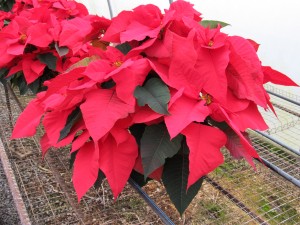Part III: By late January your poinsettia plant may look droopy and the leaves pale green. Some flowers (colorful bracts) and leaves may have dropped. To revive the plant and to program it to flower again next winter requires additional care from you starting now.
Move the plant to an east or south exposure window, offering it as much direct sunlight as possible. Keep the room temperature between 68-75°F during the day and no lower than 55°F at night. Avoid cold window drafts. Water the plant 1-2 times weekly, and never allow the plant to sit in water. If leaves shrivel and drop, you may be under/over watering it. Keep room humidity high, but do not mist the plant directly.
In early March repot into a slightly larger container, adding new potting soil. Cut the plant back by two-thirds to stimulate all new shoot growth. Feed every 2-3 weeks with a water-soluble plant fertilizer according to label directions.
By late April move the poinsettia outdoors under partial shade when daily temperatures hover above 55°F and bring it back indoors when evening temps drop.
By mid to late May the poinsettia is safe to move permanently outdoors. Set the poinsettia on a partially sunny (not direct sun) deck or patio area or under a shade tree. Continue to fertilize every 2-3 weeks.
From June thru September 10th, pinch growing tips back 2-3 inches every 3-4 weeks to develop a well-branched compact plant. If not pinched, the plant will grow tall and spindly. Continue watering and fertilizing until mid-September when plant is brought indoors to initiate re-blooming.
Previous Blogs about Care of Poinsettias (dated: 12/18/10 and 12/20/10). Part IV-“Steps in Re-blooming Your Poinsettia” will be published in September.


 Posted in
Posted in 
